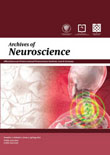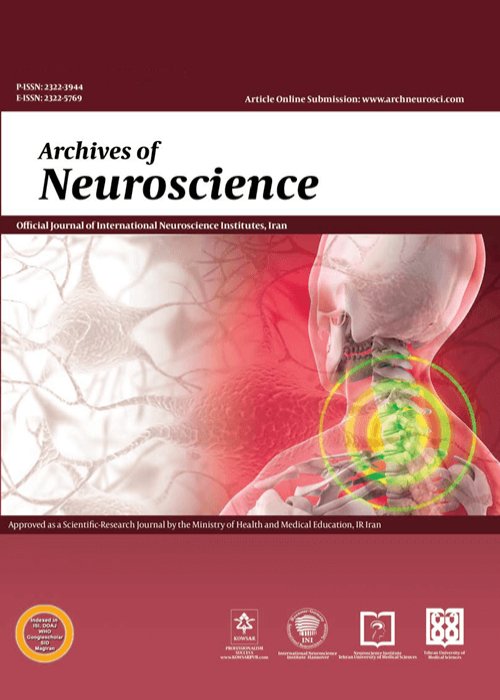فهرست مطالب

Archives of Neuroscience
Volume:3 Issue: 2, Apr 2016
- تاریخ انتشار: 1395/05/04
- تعداد عناوین: 11
-
-
Page 2Context: The human lesser petrosal nerve (LPN) is a branch of the glossopharyngeal nerve (IX), with contributions from the facial (VII) and vagus (X) nerves. Its formation and course are highly variable and complicated. The purpose of this article was to review the literature regarding the clinical anatomy of the LPN.
Evidence Acquisition: The existing literature regarding this nerve was critically reviewed, with emphasis on its clinical significance.ResultsThe LPN conveys the preganglionic parasympathetic fibers derived from the superior and inferior salivary nucleus. It is composed of fibers from the tympanic branch of the IX, the nervus intermedius of the VII, and the auricular branch of the X. The fibers from the nervus intermedius and the auricular branch of the X separate from the VII as the communicating branch, which then joins the tympanic branch of the IX to form the LPN. The LPN leaves the middle ear and enters the middle cranial fossa through canaliculus innominatus. It runs under the dura in its own groove. In the infratemporal fossa, it reaches the otic ganglion. The postganglionic parasympathetic fibers distribute mainly to the parotid gland. Combined damage to the greater superficial petrosal nerve (GSPN) and the LPN is associated with face hyperemia and profuse salivation from the parotid gland (following atropine administration), lacrimation (crocodile tears syndrome), and mucus nasal secretion. These phenomena are explained by the development of an ephaptic relation between the damaged nerves. An understanding of the relationships of the LPN will reduce the likelihood of confusing it with the GSPN during surgical approaches to the middle cranial fossa.ConclusionsThe LPN is anatomically one of the most complicated nerves in humans. Quite thin and small, it follows a variable and complicated course to serve primarily the preganglionic part of the parasympathetic innervation of the parotid gland. Its clinical significance results mainly from its close relation to the GSPN on the floor of the middle cranial fossa.Keywords: Canaliculus Innominatus, Greater Superficial Petrosal Nerve, Lesser Petrosal Nerve, Otic Ganglion, Parasympathetic Fiber, Tympanic Branch of the Glossopharyngeal Nerve -
Page 3Democritus of Abdera (b. circa 460-457 BCE; d. circa 370-351 BCE) has been called the father of modern science. With his teacher Leucippus, they co-founded the atomic theory. Concerning neuroscience, Democritus accepted Alcmaeons premise of the brain being the seat of the mind, and further formulated a triune concept of the human psyche. He contributed ideas to the physiological mechanisms of the senses and perception, and devoted considerable attention to the theory of knowledge, emphasizing subjectivity and the limitation of the human sensory apparatus.Keywords: Alcmaeon of Croton, Democritus of Abdera, History of Neuroscience, Triune Psyche, Presocratic Philosophers, Atomists
-
Page 4BackgroundFlow experience is thought to enhance health-related quality of life by mitigating stress and providing a sense of achievement. The associations between flow experience and subclinical psychiatric anomalies, such as schizotypal personality traits and paranoid ideation, have not been examined.ObjectivesThis study aimed to evaluate the associations between flow experience and subclinical psychiatric anomalies in a healthy population.Materials And MethodsThis cross-sectional study included 64 undergraduates from Kibi international university, Japan (42 males, 22 females; mean age 20.1 ± 1.13 years). Schizotypal personality was measured using the Japanese version of the Oxford Schizotypal Personality Scale (STA). Paranoia was measured using the Japanese-version Paranoia Checklist (JPC). Flow experience was measured using the Flow Experience Checklist (FEC).ResultsBoth the STA score and the JPC distress subscore were positively correlated with the FEC score. However, no correlation was observed between either the JPC conviction or the frequency subscore and the FEC score. Stepwise multiple regression analysis revealed that the FEC score was influenced only by the STA score.ConclusionsSchizotypal personality traits appear to enhance the quality of flow experiences, but not their frequency or duration. We suggest that these intense flow experiences serve as a distraction from psychological abnormalities, such as paranoid ideation.Keywords: Schizotypal Personality, Paranoia, Mental Health
-
Page 5BackgroundThe level of serum uric acid, as an important endogenous antioxidant, may be correlated to the different phases of mood disorders.ObjectivesThe aim of this study was to compare serum uric acid levels before and after treatment in patients with acute mania and depression.
Patients andMethodsWe measured serum uric acid in 33 manic and 10 depressed hospitalized patients, both before and after treatment. Mood disorder was diagnosed according to the DSM-IV criteria. Manic or depressive scores were measured with the Young Mania Rating Scale or the Hamilton Depression Rating Scale, respectively. Uric acid levels were compared in the acute and remission phases of the mood disorder, and the relationship of uric acid levels with the onset of response was analyzed.ResultsSerum uric acid levels were increased after bipolar disorder treatment. Serum uric acid levels were increased after bipolar disorder treatment. Moreover, depressed patients with lower uric acid levels had a faster onset of response. The uric acid levels in the acute mania patients were higher than in the acute depression patients.ConclusionsThe remission phase, in comparison to acute mania or depression, had higher levels of uric acid. Moreover, lower serum uric acid may correlate to a faster response in depressed patients. These results may support the roles of the purinergic system and of oxidative stress in the treatment of mood disorders.Keywords: Bipolar Disorder, Depressive Disorder, Remission Induction, Uric Acid -
Page 6BackgroundPrimary central nervous system lymphoma (PCNSL) is a malignant tumor, the incidence of which has been increasing in immune compromised patients during the last two decades.ObjectivesThis study was conducted to determine the most prevalent clinical presenting symptoms of PCNSL patients.
Patients andMethodsIn this retrospective descriptive study, all PCNSL patients data over a 25-year period (19902014) were assessed. PCNSL was confirmed pathologically after stereotactic biopsy in the Neurosurgery Department of Shohadaye Tajrish Hospital, Tehran, Iran.ResultsA total of 176 cases of PCNSL were enrolled. There were 107 (60.8%) male patients, with a 1.5:1 male: female ratio. The patients most commonly presented in the sixth decade of their lives, with a mean age of 47 ± 1.5 years. The most common presenting symptoms were hemiparesis (56.2%) and headache (51.7%). The periventricular white matter (51.1%) and basal ganglion (48.9%) were the most common sites of involvement, and they frequently affected the supratentorial area (84.7%).ConclusionsBased on the data from this study, hemiparesis and headache were the most prevalent clinical presenting symptoms of PCNSL. Cognitive impairment and personality changes were also common in these patients.Keywords: Central Nervous System, Lymphoma, Neurologic Manifestations -
Page 7BackgroundIschemic brain injury is among the most common causes of death and disability in humans worldwide. Recent findings suggest that neural precursors in the adult mammalian brain can be a therapeutic target in ischemic brain injuries. Curcumin stimulates neurogenesis and reduces oxidative stress in the brain.ObjectivesThe present study compared the neuroprotective effects of different concentrations of curcumin in various regions of the brain in a rat model of transient global ischemia (TGI).Materials And MethodsForty-eight adult male Wistar rats were randomly chosen as control, sham (animals only underwent TGI), treatment (100 and 300 mg/kg curcumin following TGI), and vehicle groups. The animals underwent global ischemia imposed by a 20 minute ligation of the bilateral common carotid arteries. Cell death and apoptosis in different areas of brain were evaluated after 3 or 4 weeks by Nissl staining and TUNEL assay respectively.ResultsThe number of dark neurons and apoptotic cells significantly increased after TGI. The number of TUNEL-positive cells after TGI was significantly higher in the temporal neocortex than in different regions within the hippocampus. Treatment with curcumin at a high dose reduced the numbers of dark neurons and apoptotic cells. Lower concentrations of curcumin showed a neuroprotective effect in the neocortex, whereas higher doses prevented cell death and apoptosis in the neocortex and in different regions of the hippocampus.ConclusionsRegional differences were evident with respect to the neuroprotective effects of curcumin in the temporal cortex and in the different parts of hippocampus following TGI. Further studies are needed to explore the mechanisms underlying these regional differences.Keywords: Apoptosis, Cell death, Curcumin, Ischemia, Neuroprotective Effects
-
Page 8Anesthesia: A Case ReportIntroductionSubdural hematoma is a serious but rare complication of spinal anesthesia. Differentiation between post-dural puncture headache (PDPH) and subdural hematoma can be difficult.Case PresentationA 32-year-old female patient underwent elective cesarean section under spinal anesthesia. Ten days postoperatively, the patient developed symptoms of headache and nausea, which progressed over time. The patient was brought to the emergency department on the 40th postoperative day with hemiparesis on the left side of the body. Brain MRI revealed a sub acute subdural hematoma. Progressive neurologic signs and evidence of mass effect and cerebral shifting on brain imaging were clear indications for surgical intervention. The patient recovered completely after surgical decompression.ConclusionsA high index of suspicion for the pattern and characteristics of headache, and a meticulous neurologic examination, can help the emergency physician recognize the serious entity of subdural hematoma.Keywords: Anesthesia, Spinal, Complications, Hematoma, Subdural, Post, Dural Puncture Headache
-
Page 9IntroductionAspergillus is a fungus found in the environment. In an immunecompetent person, inhalation of spores may cause localized infection. In immune compromised patients, these fungi can cause life-threatening invasive infections. Invasive aspergillosis has a poor prognosis.Case PresentationWe describe a case of cerebral aspergillosis in an immunecompetent patient. A 29-year-old woman was admitted with seizures and headaches. Magnetic resonance imaging (MRI) of the brain showed two masses one mass in the left frontal lobe and one in parietal lobe. Excisional biopsies showed granulomatous reactions, mixed inflammatory infiltration, fibrosis, and necropurulent material mixed with fungal hyphae featuring acute-angle branching and septation, which was compatible with aspergillosis. Amphotericin B deoxycholate (1 mg/kg IV daily) was begun. The results of testing for human immunodeficiency virus (HIV) and nitroblue tetrazolium (NBT) for chronic granulomatous disease (CGD) were negative. The patient had two subsequent recurrences, and surgery and medical treatments were prescribed. Presently, after two years of follow-up, she has no symptoms and her MRI is normal.ConclusionsMost cases of invasive aspergillosis show that this organism is pathogenic in immunocompromised patients; however, some case reports show that invasive aspergillosis may not be so rare in immunocompetent patients. In these patients, virulent and drug-resistant forms of aspergillus may be responsible for the disease, and treatment with antifungal agents is often ineffective, so that surgical excision is required.Keywords: Central Nervous System, Mycoses, Brain Abscess, Immunocompetence
-
Technical error in Publishing a Withdrawn Article with ID: 24311Page 11We would like to apology authors of the mentioned manuscript (Nicole Pedroarena-Leal and Diane Ruge) because after accepting their request about withdrawing their article from further publishing process by the editorial board (on March 28, 2015) and due to a technical error in the publishing system, their article was remained in our website for a while. However and after reporting by COPE Membership Assistant, we solved the technical problem. Hereby we clarify that an article (ID: 24311) was published in error due to a technical issue after the authors withdrew the submission with the journals agreement. Besides we declare that the publication of the work elsewhere does not thus constitute duplicate publication.Keywords: Withdrawn Article


